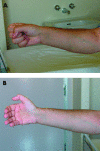Myotonic dystrophy and the heart
- PMID: 12433913
- PMCID: PMC1767476
- DOI: 10.1136/heart.88.6.665
Myotonic dystrophy and the heart
Figures



References
-
- Mathieu J, Allard P, Potvin L, et al. A 10 year study of mortality in a cohort of patients with myotonic dystrophy. Neurology 1999;52:1658–62. ▸ This is a recent longitudinal study involving a large population of DM patients, followed for 10 years, which extensively investigates the natural history and the causes of death associated with the disease. - PubMed
-
- Melacini P, Villanova C, Menegazzo E, et al. Correlation between cardiac involvement and CTG trinucleotide repeat length in myotonic dystrophy. J Am Coll Cardiol 1995;25:239–45. ▸ This excellent work points out the possible predictive value of CTG repeats size on cardiac conduction abnormalities and their severity, adding also important information on the role of late potentials in predicting VT. - PubMed
-
- Saba S, Vanderbrink BA, Luciano B, et al. Localization of the sites of conduction abnormalities in a mouse model of myotonic dystrophy. J Cardiovasc Electrophysiol 1999;10:1214–20. ▸ This is one of the few experimental control studies in a mouse model of DM where affected mice underwent complete EPS, showing the higher predilection to the infrahissian tissue for conduction abnormalities related to DMPK loss. - PubMed
-
- Jaspert A, Fahsold R, Grehl, et al. Myotonic dystrophy correlation of clinical symptoms with the size of CTG repeats. J Neurol 1995;25:239–45. - PubMed
-
- Groh W, Lowe M, Zipes D. Severity of cardiac conduction involvement and arrhythmias in myotonic dystrophy type 1 correlates with age and CTG repeat length. J Cardiovasc Electrophysiol 2002;13:444–8. - PubMed
Publication types
MeSH terms
LinkOut - more resources
Full Text Sources
Medical
